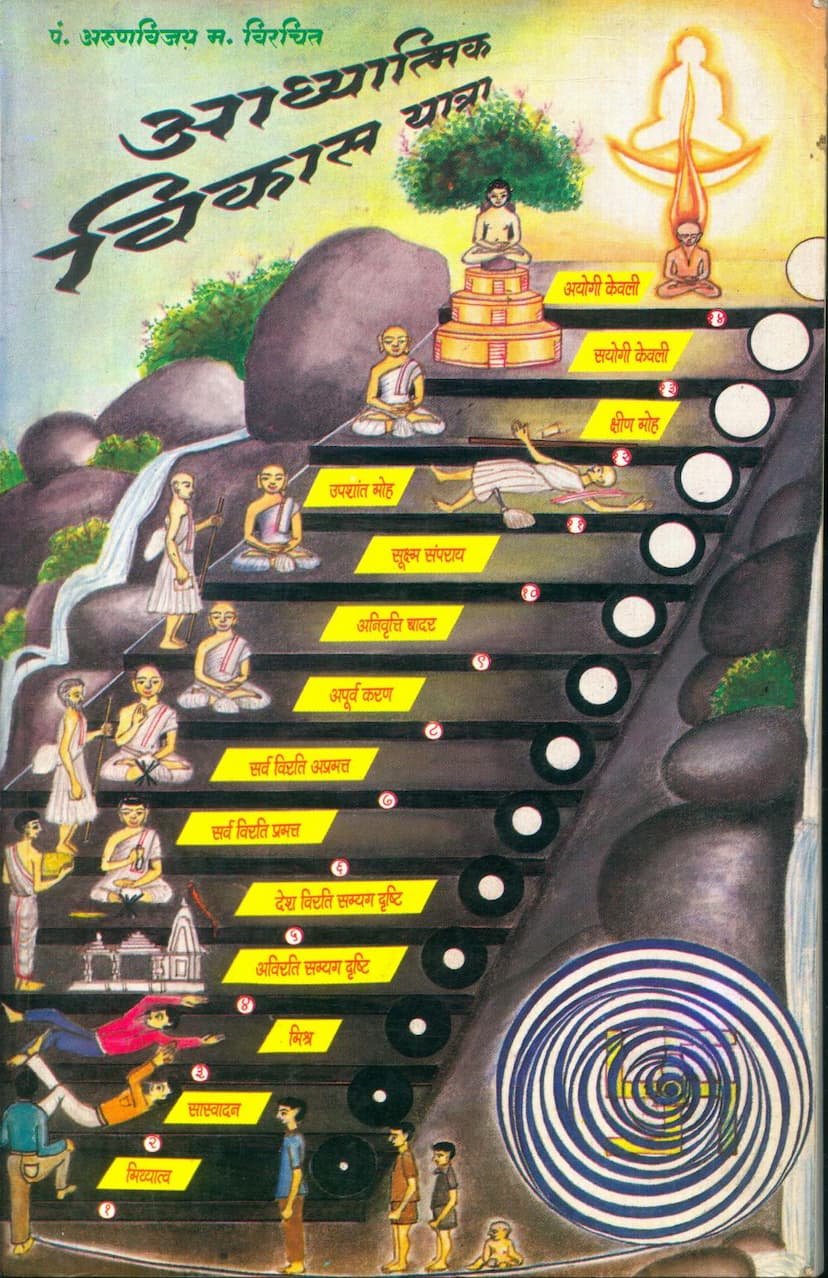Aadhyatmik Vikas Yatra Part 01
Added to library: September 1, 2025

Summary
Aadhyatmik Vikas Yatra Part 01: A Comprehensive Summary
This document is the first part of a multi-part series titled "Aadhyatmik Vikas Yatra" (Spiritual Development Journey), authored by Pandit Arunvijay Maharaj and published by Vasupujyaswami Jain SMP Sangh. It focuses on the 14 stages of spiritual progress in Jainism, known as Gunasthana, explaining the journey of the soul from mundane existence to liberation.
The book is presented as a compilation of lectures given by Pandit Arunvijay Maharaj during a Chaturmas (a four-month period of religious retreat) in Bangalore in 1995. The initiative to publish these lectures was driven by Advocate Bhanwarlal Baid, who sought to commemorate his late parents, wife, and daughter-in-law, all of whom were devout individuals.
Key Themes and Content:
-
The Spiritual Journey (Gunasthana): The core of the book is the detailed explanation of the 14 Gunasthana. These represent the progressive stages of a soul's spiritual evolution, moving from the lowest state of ignorance and delusion (Mithyatva) through various levels of rectified perception, partial renunciation, and increasing spiritual purity, ultimately reaching the highest states of Kevala Gnan (omniscience) and liberation (Moksha). The visual representation on page 1 provides a clear diagram of these stages.
-
The Role of the Soul and Karma: The text emphasizes the Jain understanding of the soul (Jiva) and its interaction with karma (Karma). The soul's journey is seen as a process of shedding karmic impurities to reveal its inherent pure nature. The 14 Gunasthana are a map of this journey, illustrating the soul's progress through different states of karma and spiritual development.
-
Dedication and Inspiration: Advocate Bhanwarlal Baid's preface highlights his personal motivation for this publication, stemming from the spiritual inclination of his deceased family members and his own deep interest in the Gunasthana concept. He expresses gratitude to Pandit Arunvijay Maharaj for his scholarly and accessible approach to explaining this complex philosophical topic.
-
Pandit Arunvijay Maharaj's Expertise: The publisher's note and the author's brief bio (on the last page) describe Pandit Arunvijay Maharaj as a highly learned scholar and eloquent speaker, known for his ability to explain intricate Jain philosophy with clarity, often using visual aids like chalkboards and diagrams. His previous work, "Karma ki Gati Nyari" (The Unique Nature of Karma), is also mentioned, indicating his proficiency in spiritual discourse.
-
The Text's Structure and Approach: The book aims to make the profound concepts of Jainism accessible to the general public. The use of simple language, logical explanations, and the incorporation of illustrations are highlighted as key features that aid understanding. The text intends to guide readers on their own spiritual path, enabling them to attain spiritual benefit and progress.
-
Community and Sponsorship: The publication was made possible by the support of the Shri Vasupujyaswami Jain Shwetambar Murti Pujak Sangh, Bangalore, who managed the printing and distribution. It also acknowledges contributions from various donors.
-
Philosophical Underpinnings: The book delves into fundamental Jain principles such as the nature of the soul, the causal relationship between actions and their consequences (karma), the concept of liberation, and the path to achieve it through right faith, knowledge, and conduct. It presents the Gunasthana as a comprehensive framework for understanding spiritual growth, encompassing the entire spectrum from worldly attachment to ultimate freedom.
Overall Purpose:
The primary purpose of "Aadhyatmik Vikas Yatra Part 01" is to illuminate the path of spiritual development as outlined in Jainism, specifically through the framework of the 14 Gunasthana. It serves as an educational and inspirational guide for individuals seeking to understand the soul's journey and its progressive ascent towards spiritual purity and ultimate liberation. The dedication to spiritual principles and the clear, structured explanation make it a valuable resource for Jain education and practice.